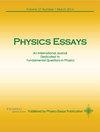Contradiction in Einstein’s subjective explanation of the gravitational and kinematic time dilation
IF 0.5
Q4 PHYSICS, MULTIDISCIPLINARY
引用次数: 2
Abstract
Einstein’s special and general relativity are relics from before quantum physics. If forces are transmitted by quanta, this must also apply to gravity. As light consist of quanta, it is only logical that gravitational quanta interact with light. In my article “Cognitive bias in physics with respect to Einstein’s relativity, demonstrated by the famous experiment of Pound and Rebka (1960), which in reality refutes Einstein’s general relativity” [R. G. Ziefle, Phys. Essays 35, 91 (2022)], I could demonstrate that Einstein’s “proper time” t 0 does not refer to reference frames but to gravitational potentials. That is why “Newtonian quantum gravity” [R. G. Ziefle, Phys. Essays 33, 99 (2020)] can predict the correct curvature of a light beam at the surface of the Sun. Also, the phenomena observed at the binary pulsar PSR B1913 + 16 can precisely be predicted by merely applying Kepler’s second law. If gravitational quanta move away from masses with the constant speed c of light, this coincides with Einstein’s postulate of a constant speed c of light with respect to reference frames, as a mass, such as a star or a planet, can also be defined as a reference frame. Therefore, Einstein’s found by chance an artificial and complicated method to calculate changes in space-time caused by motion, which are in reality additional gravitational effects caused by the relative velocity between gravitational quanta emitted by masses and other masses or photons.爱因斯坦对引力和运动学时间膨胀的主观解释中的矛盾
爱因斯坦的狭义相对论和广义相对论是量子物理学之前的遗留物。如果力是通过量子传递的,那么这一定也适用于重力。因为光是由量子组成的,所以引力量子与光相互作用是唯一合乎逻辑的。在我的文章“物理学中对爱因斯坦相对论的认知偏差,由庞德和Rebka(1960)的著名实验证明,这在现实中驳斥了爱因斯坦的广义相对论”[R。G.齐夫勒,物理学家。[论文35,91(2022)],我可以证明爱因斯坦的“固有时”不是指参考系,而是指引力势。这就是为什么“牛顿量子引力”[R。G.齐夫勒,物理学家。[论文33,99(2020)]可以预测太阳表面光束的正确曲率。此外,在双星脉冲星PSR B1913 + 16上观测到的现象可以通过开普勒第二定律精确地预测。如果引力量子以恒定的光速c远离质量,这与爱因斯坦关于参考系的恒定光速c的假设是一致的,因为质量,比如恒星或行星,也可以被定义为参考系。因此,爱因斯坦偶然发现了一种人工的复杂方法来计算运动引起的时空变化,这种变化实际上是由质量发出的引力量子与其他质量或光子之间的相对速度引起的额外引力效应。
本文章由计算机程序翻译,如有差异,请以英文原文为准。
求助全文
约1分钟内获得全文
求助全文
来源期刊

Physics Essays
PHYSICS, MULTIDISCIPLINARY-
自引率
83.30%
发文量
50
审稿时长
6-12 weeks
期刊介绍:
Physics Essays has been established as an international journal dedicated to theoretical and experimental aspects of fundamental problems in Physics and, generally, to the advancement of basic knowledge of Physics. The Journal’s mandate is to publish rigorous and methodological examinations of past, current, and advanced concepts, methods and results in physics research. Physics Essays dedicates itself to the publication of stimulating exploratory, and original papers in a variety of physics disciplines, such as spectroscopy, quantum mechanics, particle physics, electromagnetic theory, astrophysics, space physics, mathematical methods in physics, plasma physics, philosophical aspects of physics, chemical physics, and relativity.
 求助内容:
求助内容: 应助结果提醒方式:
应助结果提醒方式:


